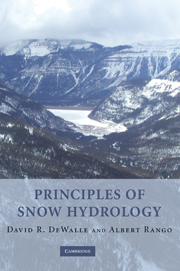Book contents
- Frontmatter
- Contents
- Preface
- 1 Introduction
- 2 Snow climatology and snow distribution
- 3 Snowpack condition
- 4 Ground-based snowfall and snowpack measurements
- 5 Remote sensing of the snowpack
- 6 Snowpack energy exchange: basic theory
- 7 Snowpack energy exchange: topographic and forest effects
- 8 Snowfall, snowpack, and meltwater chemistry
- 9 Snowmelt-runoff processes
- 10 Modelling snowmelt runoff
- 11 Snowmelt-Runoff Model (SRM)
- 12 Snowpack management and modifications
- Appendix A Physical constants
- Appendix B Potential solar irradiation theory
- Index
- Plate Section
- References
12 - Snowpack management and modifications
Published online by Cambridge University Press: 18 August 2009
- Frontmatter
- Contents
- Preface
- 1 Introduction
- 2 Snow climatology and snow distribution
- 3 Snowpack condition
- 4 Ground-based snowfall and snowpack measurements
- 5 Remote sensing of the snowpack
- 6 Snowpack energy exchange: basic theory
- 7 Snowpack energy exchange: topographic and forest effects
- 8 Snowfall, snowpack, and meltwater chemistry
- 9 Snowmelt-runoff processes
- 10 Modelling snowmelt runoff
- 11 Snowmelt-Runoff Model (SRM)
- 12 Snowpack management and modifications
- Appendix A Physical constants
- Appendix B Potential solar irradiation theory
- Index
- Plate Section
- References
Summary
Snow in the global environment is altered by human activity in many ways, some intentional and others inadvertent. Among the deliberate changes made to snowpacks are blowing-snow management to benefit agriculture and transportation, forest management to protect and enhance water yields from snowpacks, urban snow management to improve transportation and habitation in developed areas, albedo modification to enhance snowmelt rates, and ski-area management for enhanced and safe recreational opportunities. The major inadvertent change that may impact snowpacks is the possibility of climate change that is being forecast for the twenty-first century. This final chapter generally discusses these human–snow interactions from the viewpoint of the snow hydrologist.
All management of snow should be based upon a thorough understanding of the processes involved at a given site and how they may be varied to accomplish a given goal. Furthermore, the management recommendations must consider acceptability, cost, ease of use, risks, maintenance requirements, and long-term environmental impacts. Many processes affecting snow that can be altered to meet management goals have been described in earlier chapters.
Blowing-snow management
Blowing-snow management generally has the objective of creating snow drifts in useful or non-problematic locations by using some type of barrier to the wind. Barriers take the form of constructed snow fences, rows of living shrubs or trees, and crop stubble. Farmers have realized for centuries that seeds and seedling plants survive and grow faster when located in furrows that accumulated small drifts of snow that supplemented soil moisture.
- Type
- Chapter
- Information
- Principles of Snow Hydrology , pp. 365 - 391Publisher: Cambridge University PressPrint publication year: 2008



